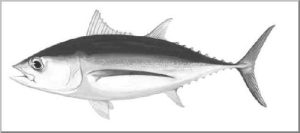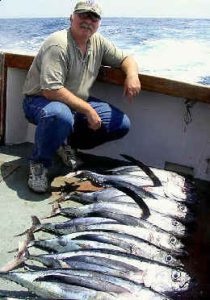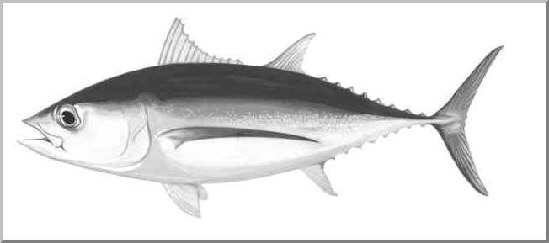Contents
All About Albacore – What You Need To Know? (2023)
Albacore is the most common tuna caught in Southern California waters. These are fast, hard-fighting, and great eating, white meat tuna.
In these fish-specific pages, I’ll try to give you all sorts of insights into the specific fish we’re discussing to increase your chances of being successful in catching them.
Albacore – Longfin Tuna

The fastest, most wide-ranging, and least controllable of all tuna, Albacore (Thunnis alalunga) are one of the most welcome visitors to Southern California. Only in years when the water temperature remains in the low 60s Fahrenheit until mid-spring will the Albacore arrive at all in Southern California. In warmer years they arrive on Central and Northern California coasts. Albacore is the best table fare of any of the tuna. They are the only fish allowed to be sold as “White Tuna” in cans. Fresh the meat is light and delicious with a decidedly meaty texture.
Because of their habits of moving in very fast, very loose schools, It’s nearly impossible for net boats to catch Albacore in commercially viable numbers. Nearly all fish are caught on hook and line, either trolled lures or by jack poles from commercial boats chumming with bait. This means there are always plenty of Albacores around for the sport fishermen to hook up.
Catching Albacore

Albacore are sometimes called “longfin tuna” for their distinctive extra-long pectoral fins. They can get as big as 90 lbs or so but are commonly in the 25-50 lb range. They’ll eagerly snap at almost any silvery object in the water when in a feeding frenzy, even bare hooks, and once on the line put up a classic, powerful tuna fight. Just because you get it on the end of your line, doesn’t mean you’ll land an albacore. Its dogged determination to get loose and seemingly herculean endurance make it a favorite among Southern California anglers.
Something like 90% of all albacore is taken in water between 62 and 67 degrees F. I recently discovered this fact in my research but my personal experience had already taught me that if the water wasn’t within a degree or two of 65, there weren’t going to be any albacore caught. I first came to realize this when commercial Albacore trolling in Central California in the early 1970s. I was holding a hose supplied by a pump in the boat that took the seawater directly from a through hull fitting to the hose and was washing down the deck. Suddenly I felt the water suddenly change from cold to warm indicating we’d just passed a thermocline. Immediately all eighteen of our trolled jigs had fish on! Then I realized the importance of water temperature for the albacore and had a remote reading sea water temperature gauge installed in my boat. From then on I noticed the water temperature when we ran into the albacore and found it was always very near 65.
Albacore are caught by trolling in likely tuna feeding areas especially over offshore banks until a school is located, then fly lining with live bait. Sometimes Albacore will be fussy with their diets and won’t touch a sardine – only anchovies. It can be tricky at these times to keep your anchovy lively when fished on bigger hooks and heavier lines needed for Albacore fishing. Also, a bait fish imitating lure or fly, if properly fished, will catch its share of these wily predators. Again, a fast retrieve with rapid, darting motions is the hot ticket. Fishing blue and silver single-tailed rubber lures “on the slide” is another very effective fishing technique for Albacore.
Preparing Albacore
My personal preference when Albacore fishing is to not allow deckhands to butcher my fish. They’ll toss the best parts of the fish overboard to settle on the bottom and become crab lunches. Know what the BEST part of an Albacore is? It’s the belly. Oh, Toro or Chu Toro (Bluefin Tuna bellies) in sushi bars is one of the most expensive things on the menu. It’s also one of the tastiest. OK, even if you can’t stand the thought of sushi, smoke those bellies for a taste sensation that will put Prime Rib to shame. It’s melt-in-your-mouth fabulous. The kama (collar) and head of the tuna are also delicious eating and are parts that get tossed overboard every day by deckhands who are too busy making a few bucks than coaching tourists on how to eat great fish meals. I get my tuna gutted and gilled, then take it to my friendly local sushi bar for proper butchering. I’ve never seen nor heard of anyone eating tuna roe but would imagine if you found some it would be very edible.
Eating Albacore
Albacore may be universally prepared in a wide variety of techniques. It’s great as sashimi, baked, broiled, grilled, steamed, poached, sauteed, smoked, marinated, just about any way you can imagine. The only way not fantastic for eating tuna is deep fried. The oil content of the fish is sufficient and frying tends to trap too much oil in the fish. Lately, I’ve been enjoying Albacore marinated in soy sauce, mirin (sweet sake), and grated garlic, then grilled on the barbeque. Tuna cooked in this manner melt in your mouth and would delight even the most ardent “I hate fishy tasting fish” picky fish eater. One of the last fish I personally caught last year had the fattest, most delicious bellies for sashimi I’ve ever tasted on any fish.
Conclusion
Hopefully, you will find this article helpful in providing information about treating and maintaining your fishing line and reel. Simply leave a comment below the article if you have any queries, and we’ll get back to you as soon as possible. Please spread the word and help us as we publish more fascinating forum posts if this is your favorite.


